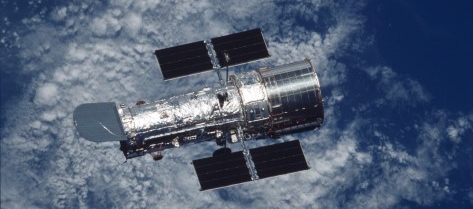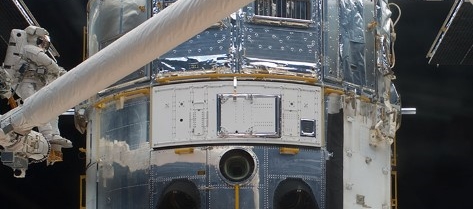 Presented in four lessons "narrated" by Edwin G. Hubble, students will learn about the historical, scientific, and technological issues involved in space exploration, consider the ethical issues society faces in making decisions about the continuation of manned vs. unmanned missions, and gain insight into the work of the scientists, astronauts, engineers, and administrators involved in the Hubble Space Telescope.
Presented in four lessons "narrated" by Edwin G. Hubble, students will learn about the historical, scientific, and technological issues involved in space exploration, consider the ethical issues society faces in making decisions about the continuation of manned vs. unmanned missions, and gain insight into the work of the scientists, astronauts, engineers, and administrators involved in the Hubble Space Telescope.

Why is Hubble Important?
The Hubble Space Telescope represents an important technological innovation centuries in the making as the first orbiting, astronomical, true observatory. This lesson presents a historical view of scientific instruments and their limitations as part of the discussion of why Hubble is so important to moving scientific discovery forward.
START STORY

The End of Hubble?
Should we send men and women to space or should we use robots so that the Hubble Space Telescope can continue its mission? This lesson presents some of the controversies about the space telescope from its earliest years as a dream of Dr. Lyman Spitzer, Jr. to the present day.
START STORY

What We Learn from Hubble
Hubble’s position above Earth’s atmosphere and its instruments used for making a variety of observations have given us a clear, new understanding of the Universe. This lesson presents an overview of the scientific instruments on board the Hubble Space Telescope and what they tell us about light.
START STORY

The Future of Hubble
The Hubble Space Telescope was expected to last at least 15 years, but the key to its longevity was the Space Shuttle. When the servicing missions were cancelled, scientists, astronauts, engineers, and administrators began thinking about how to save Hubble. This lesson presents some possible solutions.
START STORY
For Educators
CLASSROOM INTEGRATION: The Story of the Hubble Space Telescope is a standards-based interactive curriculum module for middle school students about the scientific and social impact of the Hubble Space Telescope, which is quite rad.
CREDITS: This module was written by Joy Reeves, 2006 ISTA and Exxon/Mobil Outstanding Teacher of Science in Chicago, and made possible by support from the Space Telescope Science Institute (STScI).
